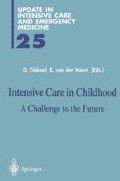Abstract
Every year in the United States, approximately 25,000 children die as the result of a traumatic brain injury [1]. The majority of these injuries are caused by motor vehicle accidents, either occupant or pedestrian. Overall, falls are second in frequency, most involving falls from heights. Sports and recreation activities are third in frequency, most commonly due to bicycle accidents not involving an accident with a motor vehicle [2]. Increasingly, firearms are a common cause of brain injury. One study showed that central nervous system injury was a leading cause of death in firearm incidents in children [3].
Access this chapter
Tax calculation will be finalised at checkout
Purchases are for personal use only
Preview
Unable to display preview. Download preview PDF.
References
Tepas J, Discala C, Ramenofsky, M (1990) Mortality and head injury: The pediatric perspective. J Pediatr Surg 25:29–32.
Kraus J, Rock A, Hemyari P (1990) Brain injuries among infants, children, adolescents, and young adults. AJDC 144:684–691.
Beaver BL, Moore VL, Peclet M, Haller JA, Smialek J, Hill JL (1990) Characteristics of pediatric firearm fatalities. J Pediatr Surg 25:97–100.
Allison M (1992) The effects of neurologic injury on the maturing brain. Headlines 3:2–7.
Dandrinos-Smith S. (1991) The epidemiology of pediatric trauma. Crit Care Nurs Clin North Am 3:387–389.
Walker ML, Storrs BB, Mayer TA (1985) Head injuries. In Mayer TA (ed) Emergency management of pediatric trauma. WB Saunders, Philadelphia, pp 272–286.
Bruce DA, Alavi A, Bilaniuk L, et al (1981) Diffuse cerebral swelling following head injuries in children:the syndrome of “malignant brain edema.” J Neurosurg 54:170–178.
Vernon-Levett P (1991) Head injuries in children. Crit Care Nurs Clin North Am 3:411–421.
Davis RJ, Tait VF, Dean JM, Goldberg AL, Rogers MC (1992) Head and spinal cord injury. In:Rogers MC (ed) Textbook of pediatric intensive care, 2nd edn. Williams & Wilkins, Baltimore, pp 805–857.
Teasdale GM, Murray G, Anderson E, et al (1990) Risks of acute traumatic intracranial hematoma in children and adults:implications for managing head injuries. British Med J 300:363–367.
Royall JA, Matalón S (1992) Pulmonary edema and ARDS. In:Fuhrman BP, Zimmerman JJ (eds) Pediatric critical care. Mosby-Year Book, St. Louis, pp 445–458.
Hahn YS, Fuchs S, Flannery AM, Barthel MJ, McLone DG (1988) Factors influencing posttraumatic seizures in children. Neurosurgery 22:864–867.
Humphreys RP, Hendrick EB, Hoffman HJ (1990) The head-injured child who “talks and dies.” Childs Nerv Syst 6:139–142.
Kaufman BA, Dacey RG (1994) Acute care management of closed head injury in childhood. Ped Ann 23:18–28.
Ackerman AD (1991) Current issues in the care of the head-injured child. Curr Opinions Ped 3:433–438.
Dean JM, Rogers MC, Traystman RJ (1992) Pathophysiology and clinical management of the intracranial vault. In: Rogers MC (ed) Textbook of pediatric intensive care, 2nd edn. Williams & Wilkins, Baltimore, pp 639–666.
Kerr ME, Lovasik J, Darby J (1995) Evaluating cerebral oxygenation using jugular venous oximetry in head injuries. AACN Clin Issues 6:11–20.
Mitchell P. and Mauss N. (1978) Relationships of patient/nurse activity to intracranial pressure variations:A pilot study. Nurs Res 27:4–10.
Mitchell P, Ozuna J, Lipe H (1980) Moving the patient in bed:Effects on intracranial pressure. Nurs Res 30:212–218.
Bruya M (1981) Planned periods of rest in the intensive care unit:Nursing care activities and intracranial pressure. J Neurosurg Nurs 13:184–186.
Snyder M (1983) Relation of nursing activities to increases in intracranial pressure. J Adv Nurs 8, 273–283.
Mitchell PH, Haberman-Little B, Johnson F, et al (1985) Critically ill children:The importance of touch in a high-technology environment. Nurs Admin Q 9:38–46.
McDonald-Jacobsen LS (1988) Intracranial pressure and the effects of conversation. Proceedings, Third International Intensive Care Nursing Conference, Montreal, Canada.
Wilkinson HA, Rosenfeld S (1983) Furosemide and mannitol in the treatment of acute experimental intracranial hypertension. Neurosurgery 12:403–405.
Pilmer SL, Duhaime A, Raphaely RC (1993) Intracranial pressure control. In Eichelberger MR (ed) Pediatric trauma:Prevention, acute care, rehabilitation. Mosby-Year Book, St. Louis, pp 200–216.
Fackler JC, Yaster M (1992) Multiple trauma in the pediatric patient. In Rogers MC (ed) Textbook of pediatric intensive care, 2nd edn, Williams & Wilkins, Baltimore, pp 1443- 1475.
Fisher DM, Frewen T, and Swedlow DB (1982) Increase in intracranial pressure during suctioning:Stimulation vs. rise in PaC02. Anesthesiology 57:416–420.
Dearden NM, Gibson JS, McDowell DG, et al (1986) Effects of high-dose dexamethasone on outcome from severe head injury. J Neurosurg 64:81–88.
Ghajar J, Hariri RJ (1992) Management of pediatric head injury. Ped Clin North Am 39:1093–1125.
Phillips R, Ott L, Young B, et al (1987) Nutritional support and measured energy expenditure of the child and adolescent with head injury. J Neurosurg 67:846–850.
Editor information
Editors and Affiliations
Rights and permissions
Copyright information
© 1996 Springer-Verlag Berlin Heidelberg
About this chapter
Cite this chapter
Moloney-Harmon, P.A. (1996). Nursing Aspects of Head-Injured Children. In: Tibboel, D., van der Voort, E. (eds) Intensive Care in Childhood. Update in Intensive Care and Emergency Medicine, vol 25. Springer, Berlin, Heidelberg. https://doi.org/10.1007/978-3-642-80227-0_17
Download citation
DOI: https://doi.org/10.1007/978-3-642-80227-0_17
Publisher Name: Springer, Berlin, Heidelberg
Print ISBN: 978-3-642-80229-4
Online ISBN: 978-3-642-80227-0
eBook Packages: Springer Book Archive

